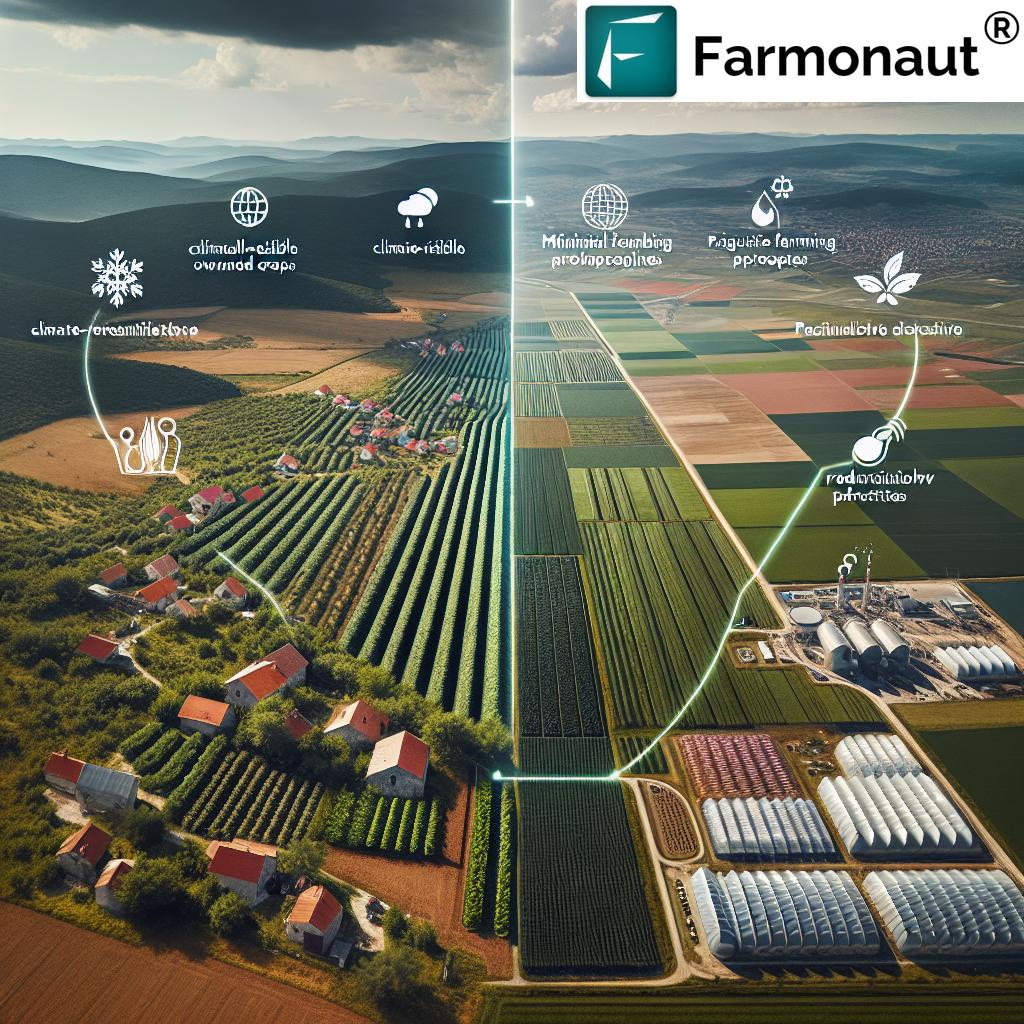Mountain Ash Ireland: 7 Powerful Uses and Folklore of This Native Tree
Meta Description: Discover the mountain ash Ireland—one of the few native Irish trees—famed for protective powers, flexible timber, folklore, and vital use in forestry. Explore its history, ecology, and sustainable significance to Ireland’s landscape and culture.
“Mountain ash is one of only 28 native tree species in Ireland, playing a key role in local biodiversity.”
- Introduction to Mountain Ash Ireland & Sorbus Aucuparia
- Botanical Profile: How Mountain Ash Grows
- Ecological Significance & Role in Irish Forestry
- Mountain Ash Folklore: Irish Legends, Spirits & Superstitions
- 7 Powerful Uses of Mountain Ash Ireland
- Mountain Ash in Brehon Law: ‘Commoner of the Wood’
- Comparison Table: Uses, Folklore, and Environmental Impact of Mountain Ash
- Advanced Forestry & Sustainability: Farmonaut Technologies
- FAQs
- Conclusion
Introduction to Mountain Ash Ireland & Sorbus Aucuparia
Mountain ash Ireland, also commonly known as caorthann in Irish or Sorbus aucuparia by its scientific name, stands tall among native Irish trees. Not only does this resilient tree flourish across Ireland’s free draining soils and uplands, but it also weaves through history as both a practical resource and an emblematic icon of local folklore. Often called “rowan,” mountain ash is a distinctive highlight in rural hedgerows, woodlands, and even within urban greenways.
As protective trees of Ireland, mountain ash brings together ecological importance, cultural depth, and practical innovation—making it one of Ireland’s most treasured native trees. Over centuries, the uses of mountain ash wood, legendary mountain ash folklore, and its nourishing role in supporting local biodiversity have secured its place in Irish life and landscape.
Botanical Profile: How Mountain Ash Grows
What is the Mountain Ash or Sorbus aucuparia Tree?
The mountain ash, or Sorbus aucuparia tree, is a deciduous tree native to Ireland and much of Europe. Despite its name, mountain ash is not a true ash (Fraxinus), but rather belongs to the rose family (Rosaceae). Its delicate, feather-like leaves and clusters of vibrant red-orange berries make it instantly recognisable.
- Height: Usually 10-20m when mature.
- Lifespan: 80-120 years on average.
- Best Soil: Grows best in free draining soils—making it ideal for uplands, heath, and sloped pastures throughout Ireland.
- Location: Ubiquitous across Irish hillsides, hedgerows, and woodlands.
- Berries: Arrays of bright berries support local bird and insect populations each autumn.
Why Mountain Ash Is Rarer Than You Think…
Despite being one of the most common native Irish trees, the mountain ash is still part of a select group—only 28 trees are considered truly native to Ireland’s soil. Its unique adaptations, such as thriving on rocky ground and in free draining locations, help define the complexion and resilience of Irish natural heritage.
Mountain Ash Ireland & Modern Sustainability
Today, preserving our mountain ash populations is key for supporting Irish woodlands. Their ability to thrive in less fertile and free draining soils means they are not in competition with commercial conifers and can help restore biodiversity in upland, reforested, or marginal lands. For farmers and landowners interested in rewilding and sustainability, mountain ash Ireland remains a top tree species.
Did You Know?
A single mature mountain ash can sequester an estimated 20–30 kg of CO₂ per year, while also providing food, shelter, and habitat for over 30+ native Irish bird and insect species.
Ecological Significance & Role in Irish Forestry
As our environment faces pressures from climate change and intensive agriculture, native tree species like the mountain ash become fundamental to the health and longevity of Irish woodlands. Let’s examine the tree’s core ecological roles:
- Support for Biodiversity: Mountain ash berries are essential food for birds such as blackbirds, thrushes, and waxwings. Its branches and foliage harbor butterflies, moths, and beneficial insects.
- Soil Stabilization: Perfect for free draining soils; its root structure controls erosion in upland areas.
- Wildlife Habitat: Mountain ash creates shelter and nesting spots in otherwise exposed landscapes, supporting wildlife resilience year-round.
- Pioneer Species: This hardy native tree can colonize disturbed ground, withstand poor and rocky soils, and aid in natural woodland regeneration—excellent for sustainable forestry planning.
In modern Irish forestry, we recommend the mountain ash for mixed native woodland planting, shelterbelt design, and as part of eco-restoration projects. Its tolerance for less productive soil makes it invaluable for improving marginal land sustainably.
“Mountain ash timber’s flexibility made it vital for crafting tools and walking sticks in Ireland for centuries.”
How Mountain Ash Fits Modern Forest Management
Using satellite-based technologies and data-driven insights for tree monitoring, such as those offered via Farmonaut’s Carbon Footprinting platform, we can now measure the environmental impact of mountain ash plantings in real time. Understanding carbon sequestration and biodiversity indices empowers Irish forestry managers to make sustainable decisions for both economic and ecological gain.
Mountain Ash Folklore: Irish Legends, Spirits & Superstitions
Protective Trees of Ireland—The Power of Mountain Ash
When exploring mountain ash folklore, it’s clear the tree resonates with an enduring sense of magic, protection, and spiritual symbolism in Irish culture. Often planted by our ancestors near houses, gateways, and holy wells, mountain ash was beloved as a shield against evil spirits and otherworldly dangers. Its branches symbolized hope, courage, and boundaries between the visible and invisible realms.
- Ward Against Evil: In Irish superstitions, a sprig of mountain ash was said to keep away fairies and spirits.
- Protective Boughs: “Protective trees Ireland” traditions dictated branches be placed over doorways, stables, and children’s cribs.
- May Processions: Mountain ash twigs were carried in folk processions to banish bad luck and guarantee safe passage.
- Special Timber: Sticks made from mountain ash wood were thought to bring luck to travellers and ward off curses from malevolent beings.
Mountain Ash in Irish Trees and Superstitions
The superstitious reputation of the mountain ash was so strong that to cut one down, especially near a dwelling, was considered unlucky—its presence was a protective force in the landscape. Stories abound throughout Ireland of homes and farms enjoying “fair winds” and “calm seasons” when flanked by a vigorous mountain ash.
Linking Folklore to Modern Practice
While many Irish tree superstitions have faded, the attitude of stewardship and respect for our native trees remains with us. The symbolic protection once offered by mountain ash now echoes in our commitment to safeguarding Ireland’s woodland heritage for future generations.
7 Powerful Uses of Mountain Ash Ireland
1. Mountain Ash Timber Uses: Strength and Flexibility
The timber of mountain ash is remarkably strong and flexible—qualities highly prized in Ireland for centuries. Its pale, dense wood resists splitting.
- Perfect for making hurleys (the stick used in the Irish sport of hurling)—before ash shortages, mountain ash was a favored choice for its resilience.
- Its flexibility and strength made mountain ash timber indispensable for creating walking sticks, tool handles, and fishing rods.
- Peg and bar construction in boats capitalized on its ability to withstand repeated loading and adverse weather.
Today, with increased focus on sustainability, mountain ash timber uses are receiving renewed interest in woodworking, eco-friendly furniture, and artisan crafts.
2. Furniture & Everyday Woodcraft
Mountain ash wood has always held a practical place in Irish homes:
- It’s commonly used in the fashioning of chairs, stools, and shelving.
- Craftspeople select it for its ease of carving and beautiful pale hue.
- Uses of mountain ash wood extend to toys, kitchen utensils, and even musical instruments—an aspect treasured in folk culture.
3. Making Boats & Traditional Tools
Seafaring and fishing, core to Ireland’s coastal life, leaned on mountain ash timber. Boat ribs, pegs, and pins used the tree’s robust grain. Its reliability under strain allowed it to withstand salt spray and repetitive stress in fishing vessels and small currachs.
4. Landscaping & Shelterbelts
Landscape designers and environmentally-aware farmers prize mountain ash for shelterbelts, native hedgerows, and landscape planting on free draining soils. Its moderate size and attractive berries bring color and biodiversity to rural and urban environments alike.
5. Wildlife Habitat & Biodiversity Support
- Mountain ash berries feed a diverse array of wild birds, including the redwing, fieldfare, and mistle thrush.
- Supports over 30 species of insects, forming a vital link in Ireland’s natural food web.
- Spring blossoms grant early nectar for pollinators, sustaining bees and butterflies.
6. Cultural & Folkloric Uses
From being woven into maypoles to crafting magical staffs in folklore rites, mountain ash’s wood and fruit have had a prominent symbolic function. Amulets, charms, and wands were popular talismans throughout Ireland.
7. Modern Forestry & Ecological Restoration
- Mountain ash is a preferred tree for reforestation on free draining uplands.
- As a pioneer species, it can help establish new native woodland quickly and support natural succession.
- Its environmental value is now calculated and tracked using carbon footprinting tools, supporting sustainable forestry practices across Ireland.
Mountain Ash in Brehon Law: ‘Commoner of the Wood’
Brehon Law & Native Trees: A Glimpse into Medieval Ireland
Brehon Law, the oldest Irish legal code, divided trees into classes according to their value and uses. Mountain ash was one of the “Commoners of the Wood,” meaning it played a supporter role but was vital to community life.
- Practical Uses: Provided essential timber for daily tasks, local construction, and farming equipment.
- Legal Protection: Felling a native mountain ash by someone other than the landowner was punishable, as each tree was valued for its unique role in sustaining the community and landscape.
(Read about Brehon Law native trees.)
This reverence continues today as contemporary forest stewardship echoes the wisdom of Irish tradition—protecting and restoring our native trees and sustaining the value they bring.
Comparison Table: Uses, Folklore, and Environmental Impact of Mountain Ash
| Use/Folklore Aspect | Description | Estimated Environmental Benefit | Cultural Significance in Ireland |
|---|---|---|---|
| Timber Use (Hurleys, Tools, Boats) | Strong, flexible mountain ash timber used for hurleys, walking sticks, and boat pegs. | Renewable resource; supports traditional crafts; 20–30 kg CO₂ sequestration per tree/year. | Value recognized in Brehon Law; integral to daily rural life and sports heritage. |
| Wildlife Habitat | Berries, flowers, and branches provide food and shelter for birds, insects, and mammals. | Supports 30+ native species; deepens local biodiversity; stabilizes ecosystems. | A symbol of wildlife abundance; featured in local songs and folktales. |
| Traditional Medicine | Bark and berries historically brewed for folk remedies (e.g., cough syrups, tonics). | Encourages sustainable, local ethnobotany; reduced environmental impact from imports. | Tied to healing rites, folklore, and rural health traditions. |
| Folklore of Protection | Ward against evil, spirits, and bad luck. Sought for superstitious rituals and charms. | Planted near dwellings; contributed to landscape connectivity; increased tree cover. | Celebrated in May processions, poetry, and oral history. |
| Role in Reforestation | Pioneer species for reforesting free draining soils; aids native woodland recovery. | Restores soil health; fixes carbon; mitigates erosion on uplands. | Honored in Brehon Law and sustainable woodland management. |
| Landscape & Amenity Value | Decorative urban & rural planting; autumn colour, flowers, berries, shade. | Enhances urban ecology; regulates microclimate; long lifespan of 80–120 years. | Visually iconic; cherished symbol in art and community spaces. |
| Biodiversity Support | Feeds pollinators, birds, insects; integral to ecological web. | Boosts pollinator populations; underpins resilience to pests/diseases. | Featured in Irish celebrations of nature and biodiversity. |
Advanced Forestry & Sustainability: Farmonaut Technologies
Ensuring the survival and thriving of native Irish trees like the mountain ash requires advanced, scalable tools for monitoring, planning, and environmental stewardship. Farmonaut delivers a suite of precision agriculture and forestry management solutions, enabling landowners, ecologists, and agribusinesses across Ireland and beyond to maximize both productivity and sustainability.
- Satellite-Based Crop and Tree Health Monitoring: Employ Farmonaut’s crop & forestry advisory technology to track crop health, tree growth, and forest cover via AI and remote sensing.
- Blockchain Traceability: Secure product traceability for forest and farm produce. Learn more about traceability solutions for sustainable supply chains.
- Carbon Footprinting & Sustainability: Quantify carbon sequestration from mountain ash and other native trees. See how to optimize eco-impact & regulatory compliance.
- Resource Management: Coordinate fleet movements and plan woodland interventions efficiently with fleet management tools for forestry and agriculture.
- Large-Scale Woodland Restoration: Farmonaut’s Agro-Admin platform supports large-scale forest and land management, essential for public woodlands and estate owners.
- API & Developer Access: Integrate satellite and weather data into your research or management system using the Farmonaut Satellite API (developer docs here).
By leveraging real-time insights via web apps, Android, or iOS platforms, all stakeholders—from farmers to forest NGOs—can uplift the condition of mountain ash habitats, support restoration, and meet sustainability targets with precision and efficiency.
FAQs: Mountain Ash Ireland & Native Trees
Q1: Is mountain ash native to Ireland?
Yes, mountain ash (Sorbus aucuparia) is one of the only 28 truly native tree species in Ireland. Its long-standing presence shapes both wild and farmed landscapes.
Q2: What are the best soils for growing mountain ash?
Mountain ash grows best in free draining soils—including poor, rocky uplands, marginal pastures, and woodland edges. It’s highly adaptable and thrives where other trees may struggle.
Q3: Are there superstitions or folklore surrounding mountain ash?
Absolutely! Mountain ash is renowned in Irish folklore as a protective tree—thought to ward off evil spirits, witches, and bad luck. Superstitions commonly saw it planted near dwellings and stables, and using its wood for walking sticks or charms was believed to ensure safe journeys and protection.
Q4: How is mountain ash timber used in Ireland?
Mountain ash timber uses include the making of hurleys, walking sticks, boat pegs, furniture, tool handles, and even traditional toys—capitalizing on the wood’s strength and flexibility.
Q5: What ecological benefits does mountain ash provide?
Mountain ash supports rich biodiversity—feeding more than 30 species of Irish birds and insects, providing shelter, stabilizing soil, and sequestering climate-warming carbon.
Q6: Can satellite technology help manage or monitor mountain ash woodlands?
Yes. Tools like Farmonaut’s satellite platform deliver real-time monitoring of crop and tree health, forestry planning, and even carbon impacts, making sustainable woodland management more accessible and affordable for all.
Conclusion: Mountain Ash Ireland—Nature’s Protector, Ireland’s Heritage
From the ancient Brehon laws to modern forestry, mountain ash Ireland epitomizes the powerful connection between people, place, and native trees. Standing tall as both a shield against superstition and a workhorse of rural industry, mountain ash (Sorbus aucuparia) continues to shape Irish heritage—safeguarding biodiversity, fueling folklore, and advancing sustainability in our changing world.
As we invest in optimal forestry management with today’s technologies, let’s cherish native Irish trees like the mountain ash for generations to come—appreciating their past, enriching our present, and enabling a resilient, nature-positive future in Ireland’s green heartlands.


















